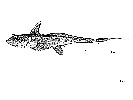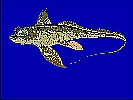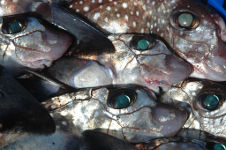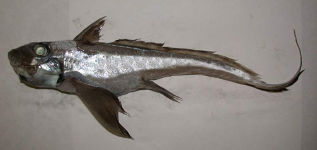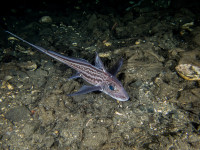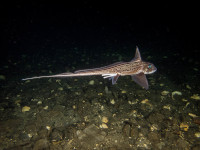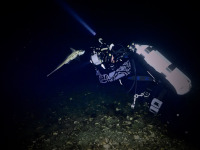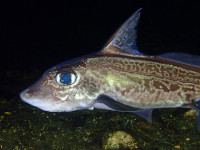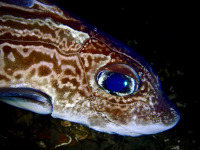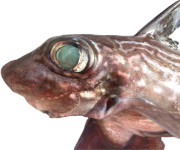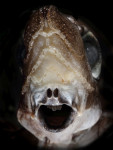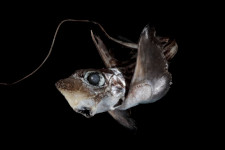Chimaera monstrosa
Linnaeus, 1758
Rabbit fish
Classification: Holocephali Chimaeriformes Chimaeridae
Reference of the original description
Systema Naturae per regna tria naturae, regnum animale, secundum classes, ordines, genera, species, cum characteribus differentiis synonymis, locis. Tomus I. Editio decima, reformata. Stockholm, Laurentii Salvii, 824pp.
Systema Naturae per regna tria naturae, regnum animale, secundum classes, ordines, genera, species, cum characteribus differentiis synonymis, locis. Tomus I. Editio decima, reformata. Stockholm, Laurentii Salvii, 824pp.
Image of the original description
No image in first description.
No image in first description.
Synonyms / new combinations and misspellings
Chimaera arctica, Chimaera argentea, Chimaera borealis, Chimaera cf. monstrosa, Chimaera cristata, Chimaera dubia, Chimaera mediterranea
Chimaera arctica, Chimaera argentea, Chimaera borealis, Chimaera cf. monstrosa, Chimaera cristata, Chimaera dubia, Chimaera mediterranea
Types
Chimaera monstrosa
Syntype: NRM: 31334;
Chimaera arctica
XXXX: No types known;
Chimaera argentea
XXXX: No types known;
Chimaera borealis
XXXX: No types known;
Chimaera cristata
XXXX: No types known;
Chimaera dubia
Holotype: MB: T.111 (141) (destroyed in 1978 fire);
Chimaera mediterranea
XXXX: No types known;
Chimaera monstrosa
Syntype: NRM: 31334;
Chimaera arctica
XXXX: No types known;
Chimaera argentea
XXXX: No types known;
Chimaera borealis
XXXX: No types known;
Chimaera cristata
XXXX: No types known;
Chimaera dubia
Holotype: MB: T.111 (141) (destroyed in 1978 fire);
Chimaera mediterranea
XXXX: No types known;
Description :
Citation: Chimaera monstrosa Linnaeus, 1758: In: Database of modern sharks, rays and chimaeras, www.shark-references.com, World Wide Web electronic publication, Version 05/2025
Please send your images of "Chimaera monstrosa" to info@shark-references.com
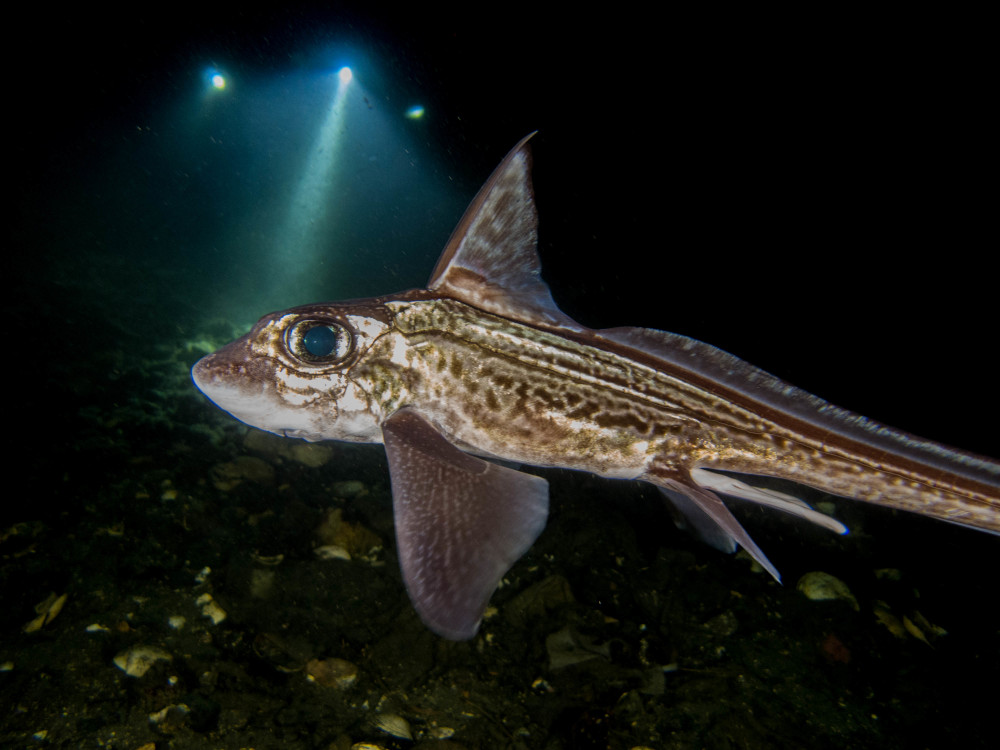
Chimaera monstrosa Linnaeus, 1758, adult male, Gravdalsviken (60.392, 5.259), Norway, on the 07/02/2020, between 20 and 29m depth © Justine Siegwald, Department of Natural History, University Museum of Bergen, Norway

Chimaera monstrosa Linnaeus, 1758, adult male, Gravdalsviken (60.392, 5.259), Norway, on the 07/02/2020, between 20 and 29m depth © Justine Siegwald, Department of Natural History, University Museum of Bergen, Norway
Common names
 Chimäre,
Chimäre,  Meerkatze,
Meerkatze,  Seekatze,
Seekatze,  Seeratte,
Seeratte,  Spöke,
Spöke,  Borrico,
Borrico,  Escopeta,
Escopeta,  Gata moixa,
Gata moixa,  Gato,
Gato,  Gato de mar,
Gato de mar,  Guinea,
Guinea,  Quimera,
Quimera,  Quimera común,
Quimera común,  Cat,
Cat,  Chimère,
Chimère,  Chimère commune,
Chimère commune,  Lapin,
Lapin,  Masca,
Masca,  Masco,
Masco,  Monstrueuse,
Monstrueuse,  Peis fera,
Peis fera,  Rat de mer,
Rat de mer,  Roi des harengs,
Roi des harengs,  Singe de mer,
Singe de mer,  Chimaera,
Chimaera,  Ghost shark,
Ghost shark,  King of the herring,
King of the herring,  Rabbit fish,
Rabbit fish,  Rabbit-fish,
Rabbit-fish,  Rabbitfish,
Rabbitfish,  Rat fish,
Rat fish,  Ratfish,
Ratfish,  Rattail,
Rattail,  Sea rat,
Sea rat,  Chimera,
Chimera,  Chimera mostruosa,
Chimera mostruosa,  Gatta di mare,
Gatta di mare,  Pisci jatta,
Pisci jatta,  Re di aringhe,
Re di aringhe,  Quimera,
Quimera,  Ratazana, Rabbit fish(
Ratazana, Rabbit fish( Rat-tail
Rat-tail
 Chimäre,
Chimäre,  Meerkatze,
Meerkatze,  Seekatze,
Seekatze,  Seeratte,
Seeratte,  Spöke,
Spöke,  Borrico,
Borrico,  Escopeta,
Escopeta,  Gata moixa,
Gata moixa,  Gato,
Gato,  Gato de mar,
Gato de mar,  Guinea,
Guinea,  Quimera,
Quimera,  Quimera común,
Quimera común,  Cat,
Cat,  Chimère,
Chimère,  Chimère commune,
Chimère commune,  Lapin,
Lapin,  Masca,
Masca,  Masco,
Masco,  Monstrueuse,
Monstrueuse,  Peis fera,
Peis fera,  Rat de mer,
Rat de mer,  Roi des harengs,
Roi des harengs,  Singe de mer,
Singe de mer,  Chimaera,
Chimaera,  Ghost shark,
Ghost shark,  King of the herring,
King of the herring,  Rabbit fish,
Rabbit fish,  Rabbit-fish,
Rabbit-fish,  Rabbitfish,
Rabbitfish,  Rat fish,
Rat fish,  Ratfish,
Ratfish,  Rattail,
Rattail,  Sea rat,
Sea rat,  Chimera,
Chimera,  Chimera mostruosa,
Chimera mostruosa,  Gatta di mare,
Gatta di mare,  Pisci jatta,
Pisci jatta,  Re di aringhe,
Re di aringhe,  Quimera,
Quimera,  Ratazana, Rabbit fish(
Ratazana, Rabbit fish( Rat-tail
Rat-tail
Short Description
Description after Ebert & Stehmann, 2013 [17836]: Field Marks: A reddish-brown body coloration with light mottling and longitudinal stripes on dorsal side of trunk, extending onto paired and median fins; pelvic claspers long and slender, divided for more than the distal one-third their length; distal edge of pelvic fins straight, not rounded. Diagnostic Features: Body elongate, slender, tapering from head to whiplike tail filament; caudal filament length 44 to 160% of total body length. Head large, snout somewhat conical, gently pointed. Eyes large, 25 to 51% head length. Lateral line canals on head appear as open grooves, canals on the snout characterized by wide dilations. Preopercular and oral lateral line canals branch together at their junction with the infraorbital canal. On rare occasions a variation of this pattern is seen in which the oral and preopercular canals share a tiny common branch. Pectoral fins narrow and triangular in shape, reach to, and just beyond, origin of pelvic fin; pelvic fin squared along its distal edge. Pelvic claspers long, slender, divided distally for nearly one-half their length; long, fleshy tips covered with a shagreen of denticles. First dorsal fin high, triangular, with a short fin–base, fin preceded by a keeled spine, strongly serrate along the posterior edge of the distal tip; spine tip when depressed reaches beyond distal tip of the first dorsal fin. Second dorsal fin long and continuous to upper caudal fin, relatively even along its length, slightly sloping posteriorly; anterior height 4 to 7% body length, posterior height 3 to 6%; lighter at the base with dark edge along distal margin. Anal fin short, low, and distinctly separate from lanceolate-shaped caudal fin. Caudal fin dorsal and ventral lobes nearly equal in height. Colour: an even reddish-brown mottled with pale splotches and stripes dorsally on the head, along the trunk, and onto the base of the fins, ventral surface an even pale gray-brown. Pectoral and pelvic–fin distal margins with distinctly dark edges in preserved specimens.
Description after Ebert & Stehmann, 2013 [17836]: Field Marks: A reddish-brown body coloration with light mottling and longitudinal stripes on dorsal side of trunk, extending onto paired and median fins; pelvic claspers long and slender, divided for more than the distal one-third their length; distal edge of pelvic fins straight, not rounded. Diagnostic Features: Body elongate, slender, tapering from head to whiplike tail filament; caudal filament length 44 to 160% of total body length. Head large, snout somewhat conical, gently pointed. Eyes large, 25 to 51% head length. Lateral line canals on head appear as open grooves, canals on the snout characterized by wide dilations. Preopercular and oral lateral line canals branch together at their junction with the infraorbital canal. On rare occasions a variation of this pattern is seen in which the oral and preopercular canals share a tiny common branch. Pectoral fins narrow and triangular in shape, reach to, and just beyond, origin of pelvic fin; pelvic fin squared along its distal edge. Pelvic claspers long, slender, divided distally for nearly one-half their length; long, fleshy tips covered with a shagreen of denticles. First dorsal fin high, triangular, with a short fin–base, fin preceded by a keeled spine, strongly serrate along the posterior edge of the distal tip; spine tip when depressed reaches beyond distal tip of the first dorsal fin. Second dorsal fin long and continuous to upper caudal fin, relatively even along its length, slightly sloping posteriorly; anterior height 4 to 7% body length, posterior height 3 to 6%; lighter at the base with dark edge along distal margin. Anal fin short, low, and distinctly separate from lanceolate-shaped caudal fin. Caudal fin dorsal and ventral lobes nearly equal in height. Colour: an even reddish-brown mottled with pale splotches and stripes dorsally on the head, along the trunk, and onto the base of the fins, ventral surface an even pale gray-brown. Pectoral and pelvic–fin distal margins with distinctly dark edges in preserved specimens.
Distribution
Eastern Atlantic: northern Norway and Iceland, Skagerrak and Kattegat south to Morocco including western Mediterranean (some isolated records from eastern part), Azores and Madeira Islands. Records from South Africa are questionable. Reported from Oshima, Japan (FMNH 89161) [3714]. Source: www.gbif.org
Eastern Atlantic: northern Norway and Iceland, Skagerrak and Kattegat south to Morocco including western Mediterranean (some isolated records from eastern part), Azores and Madeira Islands. Records from South Africa are questionable. Reported from Oshima, Japan (FMNH 89161) [3714]. Source: www.gbif.org
Human uses
fisheries: minor commercial; price category: low; price reliability: reliable: based on ex-vessel price for this species
fisheries: minor commercial; price category: low; price reliability: reliable: based on ex-vessel price for this species
Biology
Oviparous; egg-capsules slender, club-shaped with narrow lateral membranes and a horny filament at the long pointed end, 17 cm long and 3 cm wide; deposited mainly in spring and summer. The embryos developing in about 9-12 months and hatch at 10 cm length. Usually found in deeper waters in southern latitudes, while in northern areas making a summer migration to 40-100 m. Sluggish.
Oviparous; egg-capsules slender, club-shaped with narrow lateral membranes and a horny filament at the long pointed end, 17 cm long and 3 cm wide; deposited mainly in spring and summer. The embryos developing in about 9-12 months and hatch at 10 cm length. Usually found in deeper waters in southern latitudes, while in northern areas making a summer migration to 40-100 m. Sluggish.
Habitat
bathydemersal; oceanodromous [17660]; marine; depth range 40 - 1000 m (Ref. 4443), usually 300 - 500 m (Ref. 4443)
bathydemersal; oceanodromous [17660]; marine; depth range 40 - 1000 m (Ref. 4443), usually 300 - 500 m (Ref. 4443)
Remarks
shark-references Species-ID=1435;
copyright by: Cessa Rauch, Department of Natural History, University Museum of Bergen, Norway
shark-references Species-ID=1435;
copyright by: Cessa Rauch, Department of Natural History, University Museum of Bergen, Norway
Parasites (arranged by Jürgen Pollerspöck)
Myxosporea
Monogenea
Cestoda
Trematoda
Copepoda
Isopoda
Hirudinea
Myxosporea
- Bipteria vetusta Kodádková, Bartošová-Sojková, Holzer & Fiala, 2015 [22121]
Monogenea
- Calicotyle affinis Scott, 1911 [17150] [10471] [23150] [25921]
- Calicotyle kroyeri Diesing, 1850 [17150]
- Chimaericola leptogaster (Leuckart, 1830) [22616] [17150] [10471] [14626] [21219] [20123] [21756] [23150] [22485] [25816] [34006]
- Holocephalocotyle monstrosae Derouiche, Neifar, Gey, Justine & Tazerouti, 2019 [27591] [34006]
Cestoda
- Gyrocotyle confusa Van Der Land & Dienske, 1968 [10471] [6915] [21497]
- Gyrocotyle nybelini (Fuhrmann, 1931) [21497]
- Gyrocotyle sp. [21254]
- Gyrocotyle urna (Wagener, 1852) [22616] [10855] [10471] [6915] [21497] [21214] [21288] [21216] [18008]
- Gyrocotyloides nybelini Furhmann, 1931 [10471] [6915]
Trematoda
- Chimaerohemecus trondheimensis Van Der Land, 1967 [10471] [7400] [19641] [28146]
- Multicalyx elegans (Olsson, 1869) [10471]
- Plagioporus minutus Poljanskii 1952 [10471]
- Spinoplagioporus minutus (Polyansky, 1952) Skrjabin & Koval, 1958 [21505]
Copepoda
- Caligus curtus Müller, 1785 [10471]
- Caligus rapax Milne-Edwards, 1840 [10471]
- Vanbenedenia kroyeri Malm, 1860 [10471]
Isopoda
Hirudinea
- Calliobdella nodulifera (Malm, 1863) [10471]








.jpg)
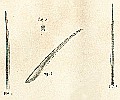
-klein.jpg)
